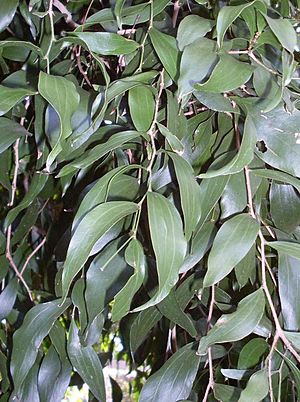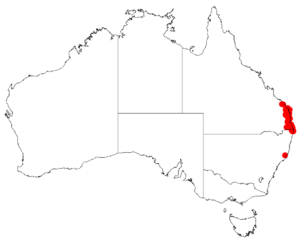Marblewood facts for kids
Quick facts for kids Marblewood |
|
|---|---|
 |
|
| Conservation status | |
| Scientific classification | |
| Genus: |
Acacia
|
| Species: |
bakeri
|
 |
|
| Occurrence data from AVH | |
The Marblewood (scientific name: Acacia bakeri) is a really big acacia tree. It's also called white marblewood, Baker's wattle, or scrub wattle. These trees can grow up to 40 m (130 ft) (about 130 feet) tall! They are long-lived trees found in rainforests in eastern Australia.
Unlike many other acacia trees, Marblewood seeds don't need fire to start growing. Sadly, this tree is considered vulnerable to extinction. Most of its original home, the lowland subtropical rainforests, was cleared away in the 1800s and 1900s.
What Does the Marblewood Tree Look Like?
Marblewood trees can be anywhere from 5 to 40 m (16 to 131 ft) tall. But often, you'll find them around 8 m (26 ft) (about 26 feet) tall. Their bark is usually grey or greyish-brown and might have small cracks, or sometimes it's smooth.
Instead of regular leaves, most Acacias have something called phyllodes. These are like flattened leaf stems that do the job of leaves. Marblewood phyllodes are always green. They are shaped like an oval, about 5 to 10 cm (2.0 to 3.9 in) (2 to 4 inches) long and 15 to 50 mm (0.59 to 1.97 in) (0.6 to 2 inches) wide. They have three or four clear veins.
The tree usually blooms in spring. It produces small, round flower-heads that are 3 to 5 mm (0.12 to 0.20 in) across. Each flower-head has 15 to 30 pale yellow or cream-colored flowers. After flowering, flat seed pods grow. These pods are 5 to 6 cm (2.0 to 2.4 in) (2 to 2.4 inches) long and 10 to 16 mm (0.39 to 0.63 in) (0.4 to 0.6 inches) wide. Inside, you'll find dark brown, shiny seeds. They are flat and oval-shaped, about 6 to 10 mm (0.24 to 0.39 in) (0.2 to 0.4 inches) long.
Naming the Marblewood Tree
The Marblewood tree was first officially described by a botanist named Joseph Maiden in 1896. He wrote about it in a paper called A giant Acacia from the Brunswick River. Later, in 1987, another botanist, Leslie Pedley, reclassified it. But in 2001, it was moved back to the Acacia group.
The second part of its scientific name, bakeri, honors Richard Thomas Baker. He worked at the Sydney Technological Museum and was the one who collected the first sample of this tree for study.
Scientists think Acacia bakeri is related to other acacia species like Acacia binervata and Acacia rothii.
Where Does Marblewood Grow?
The Marblewood tree naturally grows in a specific area of eastern Australia. You can find it from Brunswick Heads and Mullumbimby in northeastern New South Wales. Its range extends up to the Burrum River near Maryborough in southeastern Queensland.
It often grows in wet sclerophyll Eucalyptus forests and rainforests. These trees usually prefer lowland areas where the soil is rich, often from volcanoes or river deposits.


